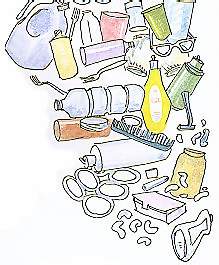Plastics
present some of the biggest dilemmas for householders. Plastics
take 200 to 400 years or longer to decompose, are made from
non-renewable petroleum and, in the case of  some
plastic foams, are believed to play a role in the destruction
of the Earth’s ozone layer. Researchers form the Woods Hole
Oceanographic Institute counted as many as 46,000 pieces of
plastic per square mile at sea.
some
plastic foams, are believed to play a role in the destruction
of the Earth’s ozone layer. Researchers form the Woods Hole
Oceanographic Institute counted as many as 46,000 pieces of
plastic per square mile at sea.
It’s hard
to find a beach or shore anywhere that’s free of plastic debris.
Tens of thousands of waterbirds, 100,000 or more marine mammals,
and similar numbers of fish die each year by ingesting or becoming
entangled in plastic debris.
Some cities
and towns have plastic recycling programs. The plastics industry,
through its “Council for Solid Waste Solutions” is working to
establish a national system to recycle plastics, but the variety
of plastic compounds poses a challenge. Only about 1% of the
25 million tons of plastic produced in 1990 was actually recycled.
Given the difficulties, the best strategy for the householder
is to avoid purchasing goods packaged or stored in plastic.
At present,
PET plastic containers (transparent like soda bottles) bearing
the recycle symbol surrounding the number 1 and the letters
PETE beneath the symbol, and HDPE plastic containers (opaque
like milk jugs) bearing the recycle symbol surrounding the number
2 and the letters HDPE beneath the symbol, are recyclable in
some areas. Call 1-800-RECYCLE to find out what type of plastics
can be recycled in your area.
“Degradable”
plastics are made to break into small particles in sunlight
or in the soil. While these products may lesson the danger of
animal entanglement, they raise new concerns. Testing needs
to occur to determine how safe the end products are and how
long these products take to degrade. Many environmental scientists
fear that the small particles may pose a greater hazard than
the larger more unsightly plastic discards.





